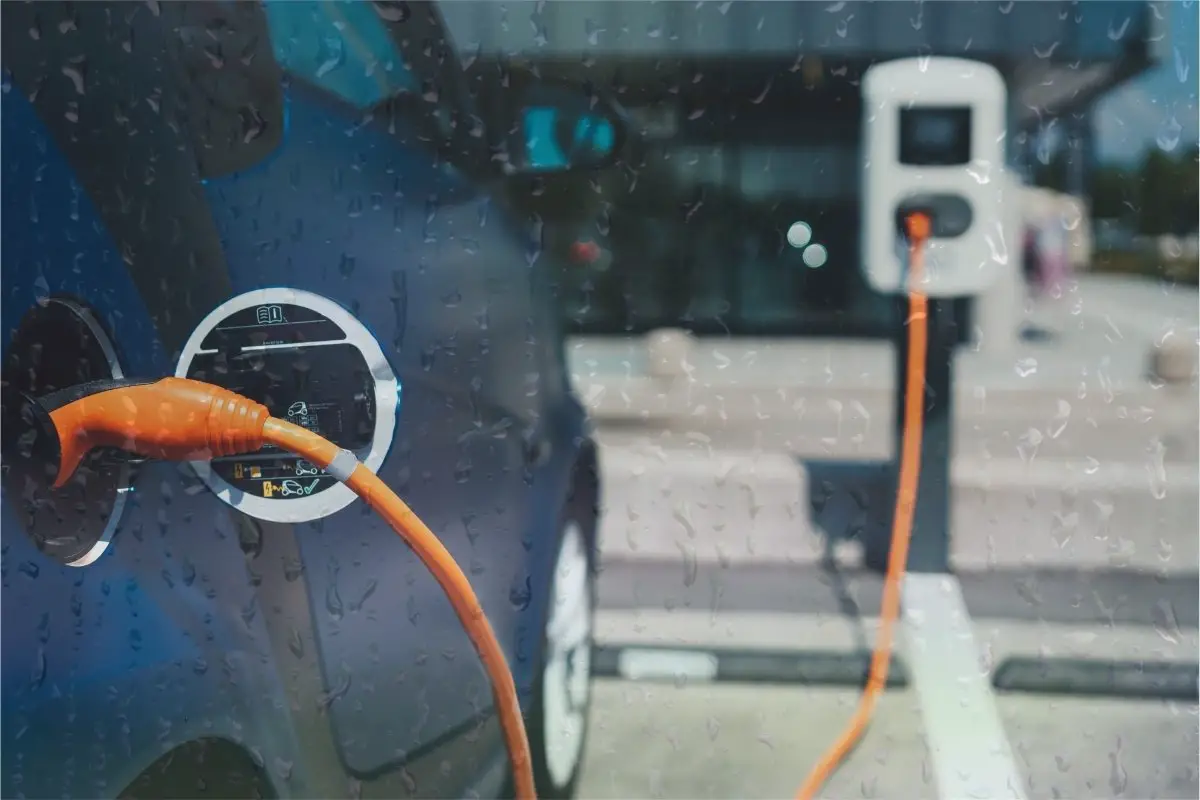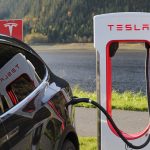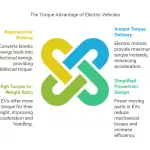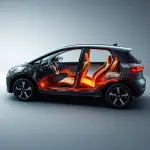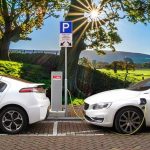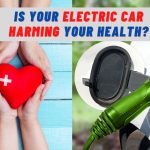Last Updated on January 23, 2025 by
Electric cars are no more likely to be struck by lightning than a diesel or gas powered car. Lightning strikes at ground level are largely a matter of luck.
If you take your electric car out in the rain and thunderstorm, you will be electrocuted!
This is the greatest misconception that surrounds highly innovative electric vehicles. What gives a boost to this belief is the fact that electrical current in water is always harmful to people.
Since these cars use electric power, people will become an easy target of a lightning storm. But these wild thoughts are easily understandable!
Every time the world witnesses a revolutionary development with a high potential for growth, multiple myths start making rounds among the common masses. This simply means it is fine to drive an electric car in light to heavy rain.
But it is equally important to understand how an electric car behaves in different situations.
What Happens if a Tesla Gets Struck by Lightning?
Tesla is a highly reputed manufacturer of EVs. It takes special care of providing people with electric cars that are completely safe for outdoor activities in various weather conditions.
In 2015, a YouTube user named Sarah Day reported an incident of how lighting affected her Tesla (Model S). When she was charging her car, a lightning bolt struck the ground near the charging station.
Eventually, the electric currents destroyed the EV batteries.
Later with the assistance of the Tesla support team, all the system’s components were restored. Additionally, it was reported that the charging car didn’t attract lightning.
Then what caused the thunderbolt to strike? Well, it was merely a chance of luck and the nearby surrounding.
Will Lightning Damage an Electric Car?
EV manufacturers take extra care in making a sturdy and efficient frame with completely insulated electrical systems to ensure people’s safety. However, there have been rare reports of electric car damage during thunderstorms.
Generally, lightning strikes channels through the metal roof, structure, and rubber tires to reach the ground when EVs are parked outside. This works like the Faraday cage.
This way, the power surge overwhelms lithium-ion batteries. Now the question of EV safety for human use comes into the picture.
Well, the electric car and its charging system have inbuilt surge protection. this prevents severe damage to the charging port, vehicle, and people.
What Happens if an Electric car gets Flooded?
During heavy rainfall and severe weather conditions, there is a huge risk of road flooding. Since the battery and electronic components are paced at the lower section of the car, the chances of electrocution are high.
But the good news is all these components are appropriately sealed. So there is hardly any chance of water or environmental damage to the internal combustion engines when you ride through a flooded track.
Can you Charge an Electric car in a Thunderstorm?
Electric cars have sealed and guarded battery power sources and electrical wiring, preventing the seepage of water, which reduces the risk of electrocution during a downpour. Additionally, electric car charging stations are made to withstand rain and protect consumers.
This is the reason why charging an EV during a thunderstorm is similar to filling fuel in a conventional gasoline car.
What Happens when Lightning Strikes an Electric Car?
The fact that electric cars have an electric motor and V battery increases people’s concerns about driving their cars in storm clouds. It is widely known that if lightning strikes a building, there is a huge power surge throughout its structure.
This requires all electrical devices to be kept away from water sources to reduce extra risks.
Despite the facts and dangers to the electric system in the rain, it is pretty safe to ride an EV in the rain. This is because the manufacturers securely place all the electrical parts in the car.
So, even if there is a bolt of lightning strikes the car, it won’t explode. Not just this, you can also take your EV to a car wash, just like diesel cars or gas-powered cars.
Do Teslas get Struck by Lightning?
When it comes to a lightning strike on Tesla, the chances are similar to electric or standard fueled vehicles. This means the car does not attract a thunderbolt.
It’s merely a fact of luck that a car gets hit by a high or low-intensity lightning bolt. Although there has been a case of lightning striking the Tesla Model S while it was connected to the supercharger cable, the car wasn’t responsible for the thunder strike.
Is it OK Charging Electric Car in Thunderstorms?
Electric cars are manufactured with intense and careful supervision to prevent the risks of even slight damage during travelling and recharging. So they can perfectly withstand severe weather conditions.
The presence of metal frames and concealed batteries ensures extended safety during the electric charge. Therefore, people can enjoy their eco-friendly and smooth ride irrespective of the weather.
Should I unplug my EV during a thunderstorm?
Like any other electronic device, electric cars have an inbuilt surge protector. This system protects all electronic parts from potential lighting damage during the charging process.
So there is no need to worry about unplugging from the charging port if the car is parked in a safe location. However, if you are outside, there can be little chance of thunderstrikes if the surrounding has an element with a pointy shape.
So, in order to avoid lightning damage during a journey, it is safer to park your car in an appropriate space. This is important because no one knows which element in the surrounding can result in a thunder attack.
How Long does it take to Charge an Electric Car?
Most new electric car owners or people are planning on buying one doubt about its efficiency. Although every model has its own specifications, some latest innovations take a limited time to recharge.

An example of this is the Tesla Model 3 Long Range, which recharges from 10% to 80% in 30 minutes using Tesla Supercharge. Apart from superfast charging, this model can cover a distance of nearly 322 miles in one go.
Similarly, most car manufacturers are developing new techniques to make electric vehicles more efficient than ICE vehicles.
Lightning Map for the USA
To avoid getting trapped in uncertain conditions while driving your electric car, it is necessary to remain updated with the chances of inclement weather. For this, it is essential to follow a trusted source that provides a satellite view of the USA.
The official site of the National Weather Service provides real-time forecasts throughout the day. Therefore, you must visit this site before planning a long or short trip to any location.
Severe Thunderstorm Warning – Should I Drive my EV?

It is completely safe to drive your electric vehicle while it’s raining or there is a thunderstorm warning. All the elements and compartments of EVs are manufactured and assembled to withstand bolt of lightning and ensure a safe ride for people.
So, riding an electric car in a thunderstorm does not increase the chances of getting hit by lighting. In fact, there is no relation between riding EVs and typical cloud-to-ground lighting.
Therefore, thinking about this situation is completely unnecessary.
Can a Helicopter Cause Lightning Strikes?
Helicopter lighting is typically seen in the North Sea between November to April. The pilots whose helicopters were knocked down by lighting assured that there was no sign of thunder.
Later it was concluded that the helicopter itself caused lighting due to the atmospheric conditions of the area. Forecasters also point out that the helicopter’s negatively charged metal objects act as the lightning bolts’ conductor metal objects of the helicopter act as the conductor for lightning bolts.
FAQs
Can a car Struck by Lightning be Repaired?
Electric cars have thick metal structures, rubber tires, and surge protectors to prevent lightning damage. Although there is hardly any chance of getting a lighting strike, the efficient design and mechanism of these cars help maintain their function.
Moreover, with professional help, minor impairments caused by lighting can easily be solved.
What Happens if an Electric car runs out of Charge on the Road?
EVs provide a detailed analysis of the remaining battery and the distance you can travel with the battery. Moreover, the car gives multiple notifications when the battery is about to discharge.
This way, you are able to search for a nearby charging station before the vehicle stops during the journey.
What would Happen if Lightning Struck a Tesla while Driving it?
When a Tesla vehicle is struck by lightning, the battery heats up due to the lightning’s energy and overheats. This might result in sparks and flames.
In the rarest situation, this process can cause certain risks if it comes in contact with the electric motors. Although there have been hardly any cases of such accidents, the combustion of motors might happen because they have volatile electric components inside them.
How Long does it take to Charge an Electric car?
Charging an electric car is an extremely convenient and fast process. Although it varies according to the brand’s specifications, some highly efficient models recharge batteries in a few minutes.
For example, Tesla Model 3 Long Range. This model has shown results in charging batteries from 10% to 80% in merely thirty minutes.
Key Takeaway
Here are the important points you want to remember about electric cars and their association with thunder lighting:
- EVs are like any conventional vehicle and have no connection with lighting bolts.
- All the electronic compartments are properly sealed to prevent water damage.
- They have powerful batteries that charge quickly to cover long distances in one go.
- Structure and mechanism of EVs are not to be blamed for the rarest lighting cases.
- Lavender Oil - February 2, 2025
- Electric Cars with Solar Panels On Roof: The Future of Sustainable Driving - January 29, 2025
- Best Cheapest Electric Car Reddit Comments - January 23, 2025

